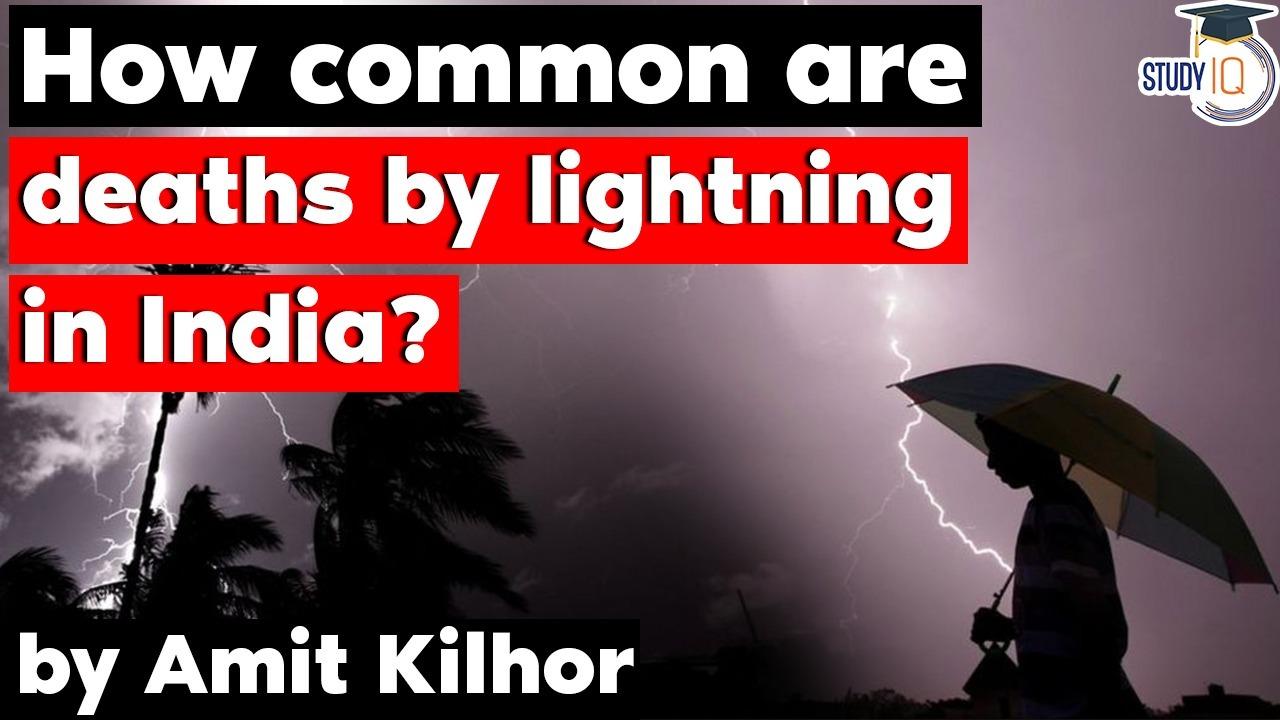Table of Contents
How lightning strikes, and why it kills
- At least 65 people were killed by lightning strikes and thunderstorms in the north Indian states of Rajasthan and Uttar Pradesh
- In the city of Jaipur in Rajasthan, 23 died after lightning hit Amer Fort — a popular tourist spot on the outskirts of the city,
- Deaths due to lightning have become frequent in the country. In July last year, 40 people were killed by lightning in Bihar in two separate incidents.

- As a whole, India sees 2,000-2,500 lightning deaths every year on average.
- Lightning is the biggest contributor to accidental deaths due to natural causes.

- Occurrences of lightning are not tracked in India, and there is simply not enough data for scientists to work with.
- Often, safety measures and precautions against lightning strikes do not receive as much publicity as other natural disasters such as earthquakes.
- Lightning is a very rapid — and massive — discharge of electricity in the atmosphere, some of which is directed towards the Earth’s surface.
- These discharges are generated in giant moisture-bearing clouds that are 10-12 km tall. The base of these clouds typically lies within 1-2 km of the Earth’s surface, while their top is 12-13 km away. Temperatures towards the top of these clouds are in the range of minus 35 to minus 45 degrees Celsius.

- it’s caused by the build-up of electric charge in cumulonimbus clouds.
- As water vapour moves upward in the cloud, the falling temperature causes it to condense. Heat is generated in the process, which pushes the molecules of water further up.
- As they move to temperatures below zero degrees celsius, the water droplets change into small ice crystals. They continue to move up, gathering mass — until they are so heavy that they start to fall to Earth.
- This leads to a system in which, simultaneously, smaller ice crystals are moving up and bigger crystals are coming down.

- Collisions follow, and trigger the release of electrons — a process that is very similar to the generation of sparks of electricity. As the moving free electrons cause more collisions and more electrons, a chain reaction ensues.

As the storm moves over the ground, the strong negative charge in the cloud attracts positive charges in the ground. These positive charges move up into the tallest objects like trees, telephone poles, and houses. A “stepped leader” of negative charge descends from the cloud seeking out a path toward the ground. Although this phase of a lightning strike is too rapid for human eyes, this slow-motion video shows it happening.

- As the negative charge gets close to the ground, a positive charge, called a streamer, reaches up to meet the negative charge. The channels connect and we see the lightning stroke. We may see several strokes using the same path, giving the lightning bolt a flickering appearance, before the electrical discharge is complete.
- Temperatures in the narrow lightning channel reach about 25,000°C. The surrounding air is rapidly heated, causing it to expand violently at a rate faster than the speed of sound, similar to a sonic boom. At about 10 m out from the channel, it becomes an ordinary sound wave called thunder.
- Thunder is effectively exploding air, and when heard close to the lightning channel, it consists of one large bang. At about 1 km away, it is heard as a rumble with several loud claps. Distant thunder has a characteristic low-pitched rumbling sound. However, beyond 16 km, thunder is seldom heard.

- There is a greater probability of lightning striking tall objects such as trees, towers or buildings. Once it is about 80-100 m from the surface, lightning tends to change course towards these taller objects. This happens because air is a poor conductor of electricity, and electrons that are travelling through air seek both a better conductor and the shortest route to the relatively positively charged Earth’s surface.
- Lightning rarely hits people directly — but such strikes are almost always fatal.
- People are most commonly struck by what are called “ground currents”.
- The electrical energy, after hitting a large object (such as a tree) on Earth, spreads laterally on the ground for some distance, and people in this area receive electrical shocks.

- It becomes more dangerous if the ground is wet (which it frequently is because of the accompanying rain), or if there is metal or other conducting material on it. Water is a conductor, and many people are struck by lightning while standing in flooded paddy fields.
- Predicting a thunderstorm over a pinpointed location is not possible. Nor is it possible to predict the exact time of a likely lightning strike.
- For reasons given above, taking shelter under a tree is dangerous. Lying flat on the ground too, can increase risks. People should move indoors in a storm; however, even indoors, they should avoid touching electrical fittings, wires, metal, and water.
- A car or other enclosed metal structure is the safest place to be in a thunderstorm. Failing that, a ditch, trench or group of shrubs of uniform height is better than nothing. Keep away from boundary areas between dissimilar terrain (water and land; rock and earth; trees and fields). Also keep at least five metres away from metal objects or other people as lightning will often jump from one object to another.
Latest Burning Issues | Free PDF






















 WhatsApp
WhatsApp